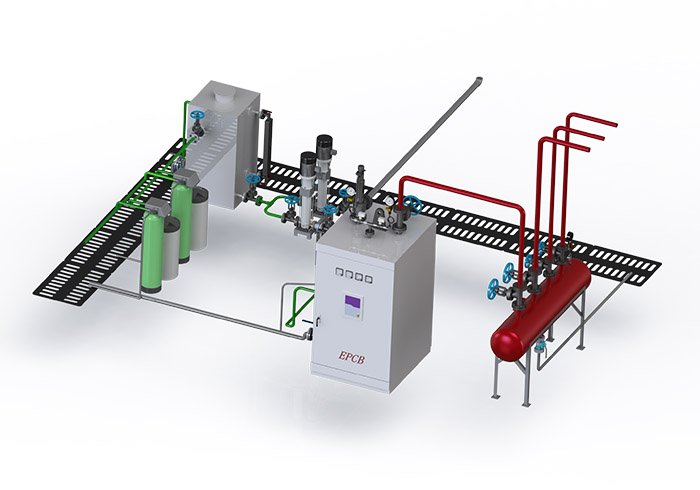Boiler is one of the commonly used special equipment, it is widely used in industrial demand. The safe operation of the boiler is particularly important. Boiler failure will cause great harm, among them boiler explosion is one of the biggest hazards.
Boiler explosions are mainly divided into two types: explosions in the furnace and explosions outside the furnace. Fire extinguishing in the boiler furnace is the main cause of boiler explosions. It leads to abnormal pressure inside the furnace, which results in a boiler explosion.
In order to prevent boiler explosion accidents, EPCB specifically summarized the causes, phenomenon and related preventive measures of boiler explosions, hoping to help everyone eliminate boiler explosion from the root cause.
Boiler Explosion Concept and Characteristics
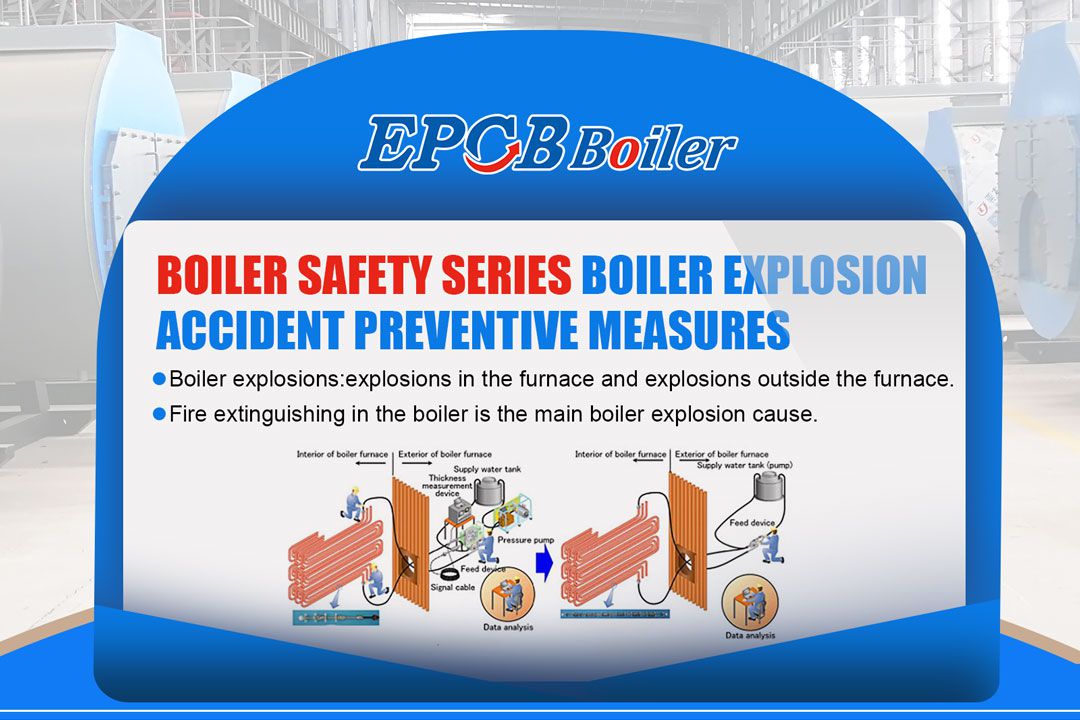
Boiler Explosion Concept
Fire extinguishing in the boiler furnace is the most important cause of boiler explosion. Fire extinguishing in the furnace is the sudden extinguishment of the burning flame.
Fire extinguishing causes the furnace air pressure to drop sharply and form a vacuum state. When the furnace wall receives a huge inward thrust from the outside air side, it is called explosions in the furnace.
The fire in the furnace fails to cut off the fuel in time, and the fuel that enters and accumulates in the furnace is suddenly burned, and the furnace wind pressure rises sharply, forming a positive pressure. When the furnace wall receives the huge outward thrust from the inner side of the furnace, it is called explosions outside the furnace.
Severe internal explosion and external explosion of the furnace will destroy the furnace wall and break the water wall tube, which is a major accident of the boiler.
Explosion in the Furnace Presentation
The amount of flue gas generated by the combustion of fuel in the furnace is greater than the amount of air sent into the furnace cavity, and the temperature during combustion is very high.
The volume of the body is large, and the sudden flameout in the furnace will reduce the actual volume of the gas in the furnace by 5-6 times, so the furnace air pressure drops sharply.
The capacity of boilers with destructive implosion accidents is generally above 500MW, of which oil-fired and gas-fired boilers account for the majority.
Explosion Outside the Furnace Presentation
The boiler external explosion accident has the following basic laws:
the relative storage of combustibles, the greater the calorific value of combustibles, the greater the pressure of the external explosion.The greater the force rise; the lower the temperature of the furnace gas before the external explosion, the greater the external explosion pressure.
When the boiler is ignited, the ignition energy is interrupted or insufficient, one or several burners suddenly lose flame during normal operation, the entire furnace is extinguished or the amount of fuel leaks into the shutdown furnace, which will cause the accumulation of combustibles.
Each cubic meter of air contains 0.05kg of pulverized coal, which is explosive. A 600MW boiler enters about 80kg of pulverized coal in the furnace per second. Therefore, an explosive combustible mixture can be formed within 1 to 2 seconds after the furnace is turned off. Therefore, the fuel must be cut off immediately when the flame is interrupted in the furnace and the furnace is extinguished.
Modern large boilers rely on operators to monitor the flameout, and it is difficult to cut off the fuel instantly. The furnace safety monitoring system FSSS (Furnace Safeguard Supervision System) must ensure the safe operation of the furnace.
For small and medium-sized boilers without a furnace safety monitoring system, the operator must monitor the furnace safety, and immediately cut off the fuel once a fire is found, and then conduct ventilation and cleaning.
Fire Extinguishing Accident in Boiler Furnace
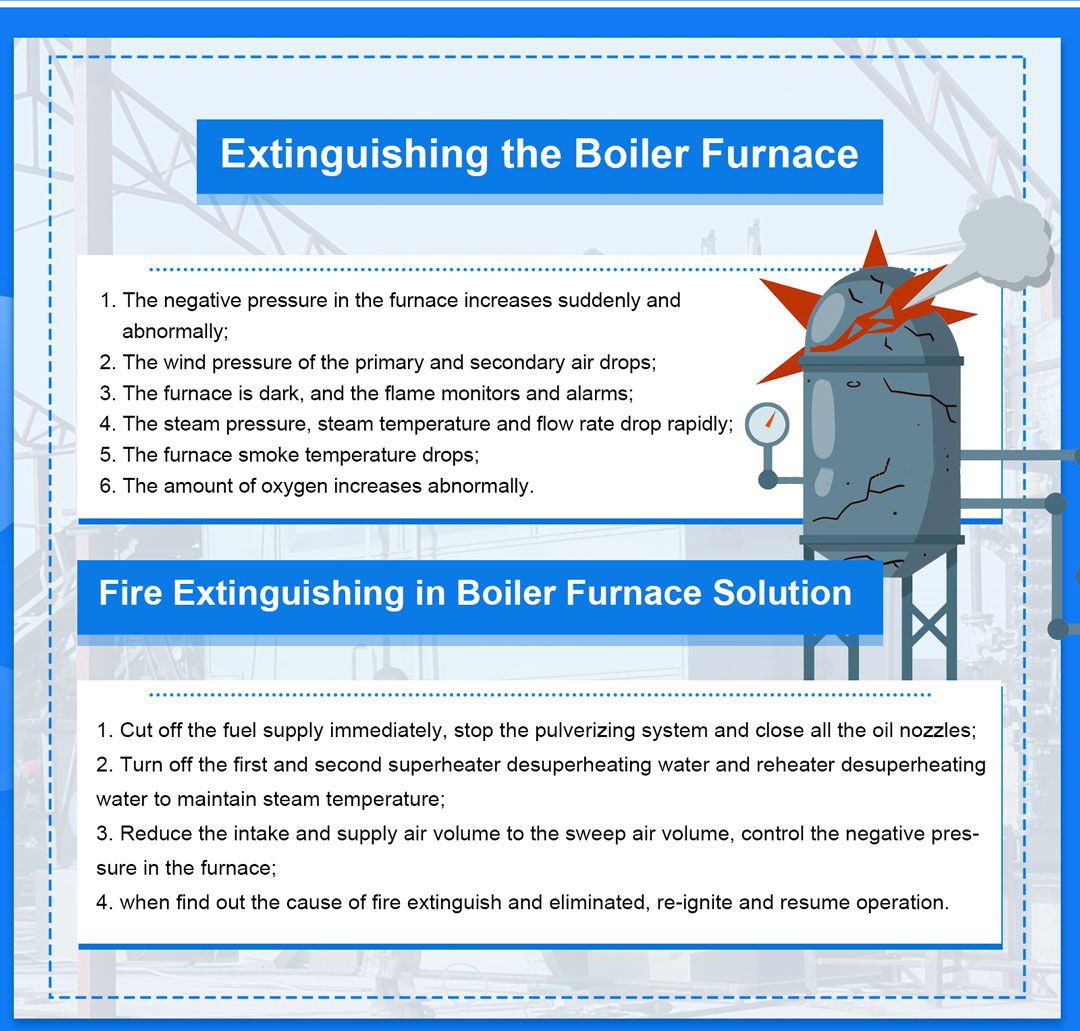
1.Fire Extinguishing in Boiler Furnace Phenomenon and Solutions
Fire Extinguishing Phenomenon in Boiler Furnace:
(1) The negative pressure in the furnace increases suddenly and abnormally;
(2) The wind pressure of the primary and secondary air drops;
(3) The furnace is dark, and the flame monitors and alarms;
(4) The steam pressure, steam temperature and flow rate drop rapidly;
(5) The flue gas temperature of the furnace decreases;
(6) The amount of oxygen increases abnormally.
When a fire occurs in the furnace, the furnace safety monitoring system FSS S responds immediately, MFT (Main Fuel Trip) acts and performs a series of automatic disposal according to the procedure.
Fire Extinguishing in Boiler Furnace Solutions
(1) Cut off the fuel supply immediately, that is, stop the pulverizing system and close all the oil nozzles;
(2) Turn off the first and second superheater desuperheating water and reheater desuperheating water to maintain steam temperature;
(3) Reduce the intake and supply air volume to the sweep air volume, control the negative pressure in the furnace, and purge for 5 minutes to suck out the fuel accumulated in the furnace;
(4) Only after the cause of the fire is found out and eliminated, is it allowed to re-ignite and resume operation.
In the case that the protection device refuses to operate, the operating personnel shall perform manual intervention in accordance with the sequence controlled by the fire protection program. After the boiler is extinguished, it is strictly forbidden to use the "deflagration method" to resume combustion to avoid serious fire and explosion accidents.
When the unit boiler extinguishes fire, the linked steam turbine and generator trip. Or steam turbines and generators quickly reduce the load to prevent the boiler steam pressure and steam temperature from falling too fast, which will affect the installation of equipment and create conditions for the unit to resume operation.
2. Fire Extinguishing in the Boiler Furnace Causes
Fire Extinguishing in Boiler Furnace Causes include:
(1) The quality of coal is too poor or the coal type changes suddenly;
(2) The furnace temperature is low during startup or low-load operation, or the air coefficient is too large, and the furnace has a large amount of air leakage, which reduces the furnace temperature;
(3) The primary wind speed is too low or too high, the airflow direction of the four-corner DC burner is turbulent, and the powder feeder is uneven;
(4) The blower or induced draft fan trips or loses power;
(5) The operation of furnace soot blowing and slag removal is improper;
(6) The water-cooled tube was blasted, and a large amount of soda was sprayed out to make the flames go out;
(7) The switch of the burner and the improper operation of the coal mill;
(8) When the unit has FCB (turbine unit failure and rapid load reduction) or RB (boiler main and infant auxiliary equipment failure and rapid load reduction) action, the burner management system automatically handles improperly;
(9) The pulverizing system, fuel system failure, etc.
3. Fire Extinguishing in the Boiler Furnace Preventive Measures
For large boilers, the main measures to prevent the boiler from extinguishing fire in the furnace are as follows:
(1) The various control systems of CCS not only ensure the economy of the boiler, but also cooperate with FSSS, which also plays a very important role in the safety of the unit. Therefore, it is necessary to strictly monitor its adjustment quality and normal function during operation. Pay special attention to the normal fuel/wind ratio. Maintain proper excess air coefficient and variable load rate to maintain flame stability and prevent the furnace from extinguishing fire. If abnormalities are found, make manual adjustments immediately, and notified thermal processing .
It is necessary to constantly understand the characteristics of coal combustion and the grinding situation of pulverized coal, so as to be aware of during operation, contact thermal engineers in time, and correctly adjust the normal value of each adjustment system to maintain good combustion conditions.
(2) Open or close the exit door of the coal mill fully or fully, never in the middle position, and combustion rate cannot be adjusted by controlling the fuel quantity of a single burner.
(3) For boilers equipped with a direct-blowing pulverizing system, when the minimum stable combustion load is required, part of the pulverizing system must be cut off, and the following one or two pulverizing systems must be retained to ensure the pulverizer supply pipeline The air-powder mixture has a certain speed, and the output of each coal mill is not less than 40%.
(4) Under any working conditions, the air volume shall not be less than about 30% of the total air volume.
(5) Always pay attention to the normal furnace pressure, and control the negative pressure between 30 and 50 Pa.
(6) During normal operation, if a certain layer of pulverized coal is found to lose flame when it is burning, if it is not caused by the failure of the flame monitor (no fault alarm), immediately put in the adjacent oil layer to support combustion, and stop the pulverizing system or powder feeder of the layer Running. Start the standby pulverizing system and the corresponding burners and put them into operation, connect to the load; and find out the reasons for the failure of the burners, and clear the defects in time.
(7) Check the coal temperature of the raw coal hopper frequently to prevent the raw coal temperature from being too high.
(8) Always monitor that the outlet temperature of the coal mill is in the normal range, and make appropriate adjustments to the given value after approval according to changes in coal quality.
(9) After the running coal mill catches fire, the system should be switched to manual operation immediately, put into the adjacent oil layer, close the hot air door, increase the raw coal input as much as possible, and continuously use cold air operation to extinguish the fire, if the coal is pulverized The outlet temperature of the machine is within a few minutes.
If it does not come down, add steam to extinguish the fire. When all the fires have been extinguished, stop adding steam and the input of grinding medium, and let the coal mill
Run with cold air for at least 5 minutes to purge the system and blow off the accumulated water vapor.
(10) If the fire is unsuccessful in Article (9), one of the following two methods can be used to extinguish the fire.
1) Stop and isolate the coal mill. Avoid stirring up any deposits in the coal mill. Do not open any damper that enters the coal mill before the fire is extinguished and the temperature drops to ambient temperature. After the fire is extinguished, the coal mill should be ground Under the premise of machine isolation, check and take out all the char and other deposits inside the coal mill to avoid re-ignition.
2) Turn off the coal feeder, let the coal pulverizer empty the fuel in it, keep the cold air passing through the coal pulverizer, until the fire is extinguished, when the coal pulverizer cools down, stop the coal pulverizer, and perform control on the coal pulverizer. Isolate, then inspect and remove all char and other deposits inside the coal mill.
(11) If there is a fire in the pulverized coal pipeline, press (10) to extinguish the fire.
(12) If the coal pulverizer that is out of service catches fire, the coal pulverizer should be isolated immediately. Turn off all dampers and baffles to the coal machine. When the fire is completely extinguished, do not open any damper to the coal mill before the temperature drops to ambient temperature and confirm that the coal mill is indeed isolated.
(13) In fuel oil operation, always check that the oil pressure and temperature in front of the furnace are normal, and when using steam atomization, check that the atomizing steam pressure is normal.
Boiler Furnace Explosion Accident
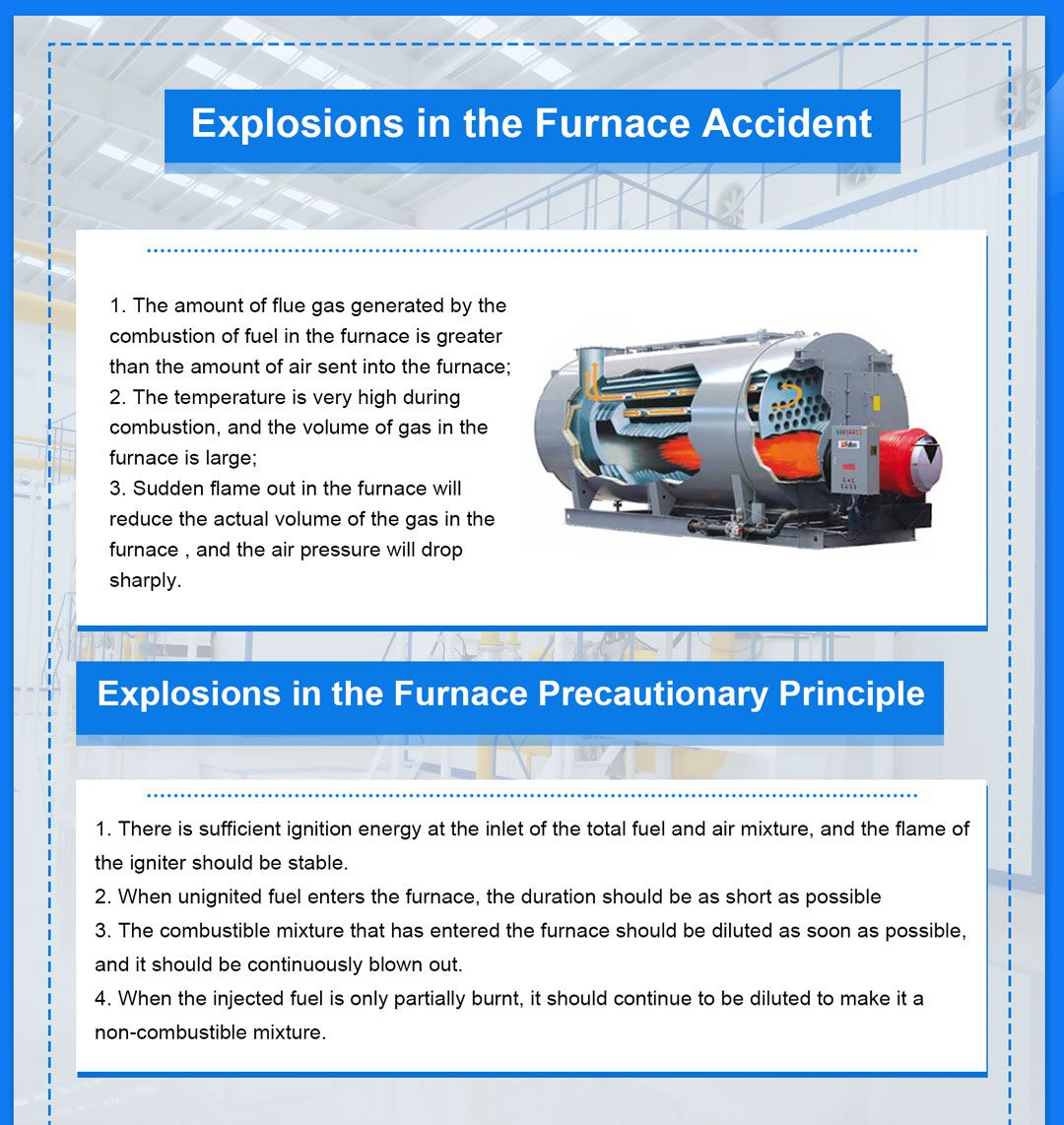
Three Necessary Conditions for the Boiler to Produce an External Explosion Accident:
(1) Sufficient amount of combustibles and oxygen;
(2) The mixture of combustible material and gas has reached the deflagration concentration;
(3) Sufficient ignition energy (open flame) exists.
If the boiler fails to cut off the fuel in time after the fire is extinguished, a furnace deflagration accident is prone to occur under the condition of an open flame. The faster the fuel is cut off, the less the amount of fuel stored in the furnace, and the less likely it is to produce a deflagration.
Main Causes of Fuel Accumulation include:
(1) It is found that the fire in the furnace is not timely;
(2) The operation time for FSSS to cut off the fuel is too long:
(3) The lag time of the coal feeder is too long;
(4) The hysteresis and closure of valves and baffles are not tight;
(5) Misjudgment, misoperation (such as continued powder injection, oil injection), etc.
Main Dangerous Conditions in which Combustibles Accumulate in the Furnace during Boiler Operation:
(1) The entire furnace fire was not detected in time, resulting in the accumulation of combustible mixture. The definition of full furnace fire extinguishing is determined by the design function of FSSS. For boilers with four-corner direct-flow burners, when monitoring the flame of the uppermost four-corner burner is the mainstay, usually 3/4 of the four flame detectors extinguish the fire, it is judged as the whole furnace fire; when monitoring the flames of each layer When the flame of the burner is extinguished by 3/4 of the flame detector, it is judged that the fire is extinguished in the whole furnace. For boilers with oppositely arranged swirl burners, all fire extinguishers are fired with burners or the proportion of fire extinguishing burners reaches a certain set value or more, and it can be judged that the whole furnace is extinguished.
(2) When multiple burners are in normal operation, one or more burners suddenly lose their flames and cannot be continued in the furnace, thereby accumulating combustible mixtures.
(3) Fuel leaks into the furnace of the deactivated boiler.
Practice has shown that more than 90% of boiler furnace explosion accidents occur during boiler start-up and shutdown or low-load operation. When operating under the above conditions, the operating conditions of the burner and the furnace flame should be closely monitored to ensure the normal operation of FSSS.
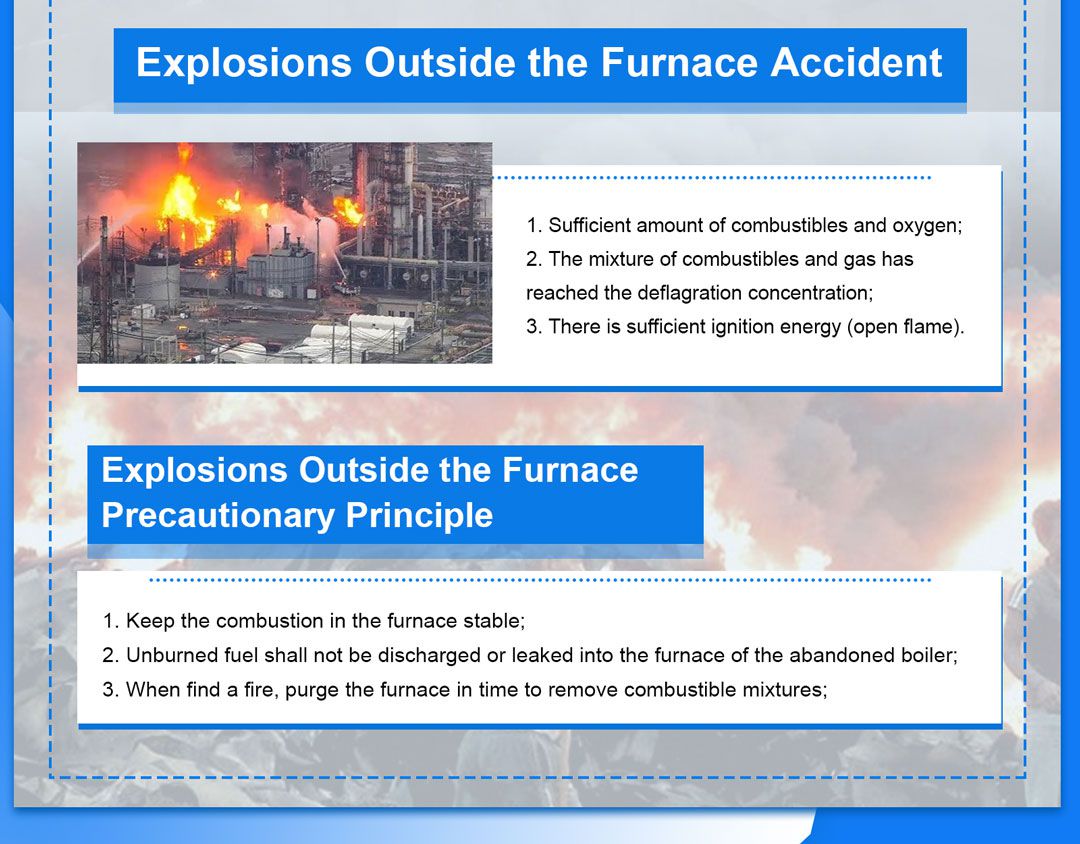
Measures to Prevent External Explosion Accidents in the Boiler Furnace:
(1) Maintain stable combustion in the furnace and maintain a higher furnace temperature;
(2) Unburned fuel shall not be discharged into the furnace of the boiler that is out of service;
(3) When a fire is found, the furnace shall be purged in time to remove combustible mixtures;
Preventive Measures against Explosion Accidents in the Boiler Furnace:
(1) When purging, it is necessary to meet the requirements of purge air volume and purge time to ensure that the combustibles in the furnace are completely purged.
(2) During ignition, the purge air volume should be maintained. When the ignition fails, unburned combustibles can be taken out of the furnace.
(3) After the ignition fails, the purge must be performed again before the ignition can be re-ignited.
(4) When the boiler starts in cold state, avoid putting it into the pulverizing system too early. Adding pulverized coal when the furnace temperature is low can easily cause difficulty in ignition of the pulverized coal, and cause unburned pulverized coal to accumulate in the furnace.
(5) When the boiler starts and stops and operates at low load, as well as when the coal type changes, the supervision of changes in operating conditions and parameters should be strengthened, and the combustion and air-to-coal ratio should be adjusted in a timely manner.
(6) Strengthen the management of the fuel system, regularly switch and test fuel equipment and ignition devices, prohibit the use of defective fuel equipment, and pay particular attention to the leakage of fuel guns.
(7) When the combustion is found to be unstable, oil should be added to support the combustion as soon as possible, and when the combustion deteriorates and obvious signs of extinguishing the fire are found, it is forbidden to add oil.
(8) Once the oil gun is deactivated, the oil inlet valve should be closed immediately.
(9) From the ignition of the boiler to the initial load of the unit, the rated air volume should be maintained at no less than about 30%, and the air regulator of each burner should maintain a certain opening.
(10) When the boiler is operating at low load, some burners and corresponding coal mills or powder feeders should be disabled, so that other operating burners and corresponding coal mills or powder feeders should be under a higher load. run.
Conclusion
Through the above content, you can have a comprehensive understanding of the boiler explosion, understand the boiler failure and take corresponding measures to actively prevent it, and your boiler can be used more safely and lastingly.
EPCB, your private boiler system expert!
Further Reading:
Boiler Safety Series | Boiler Tube Burst Causes and Preventive Measures in Boiler Accidents
Boiler Safety Guide | Industrial Boilers'Common Accidents and Solutions
Boiler Safety Series | Boiler Water Level Accidents Causes and Preventive Measures
Boiler Safety Series| Common Malfunctions and Solutions inside the Boiler
Boiler Safety Accessories and Valves Common Malfunctions and Solutions
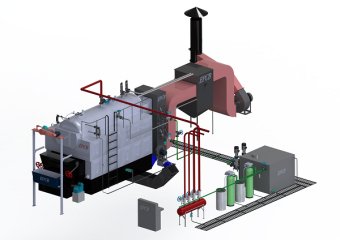 Steam Boiler
Steam Boiler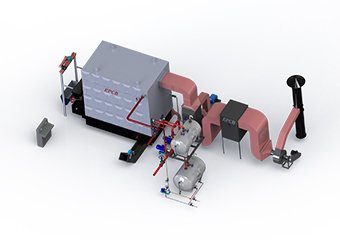 Thermal Oil Boiler
Thermal Oil Boiler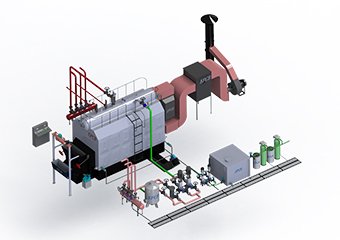 Hot Water Boiler
Hot Water Boiler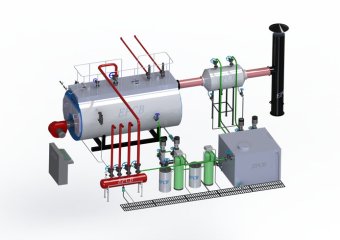 Steam Boiler
Steam Boiler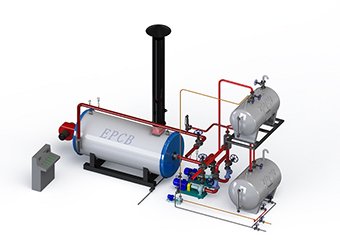 Thermal Oil Boiler
Thermal Oil Boiler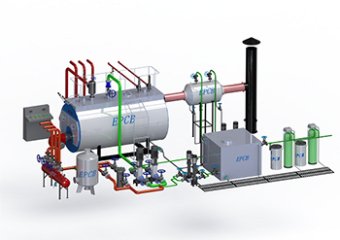 Hot Water Boiler
Hot Water Boiler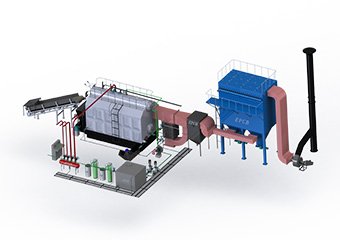 Steam Boiler
Steam Boiler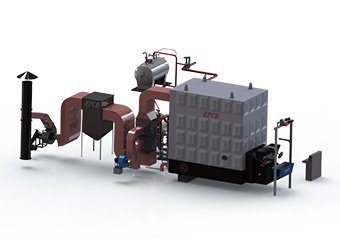 Thermal Oil Boiler
Thermal Oil Boiler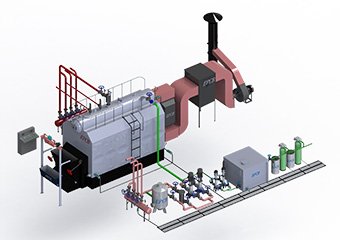 Hot Water Boiler
Hot Water Boiler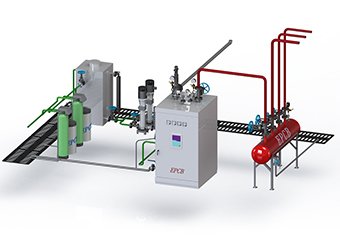 Steam Boiler
Steam Boiler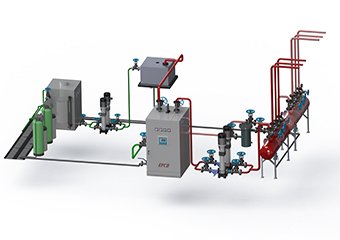 Hot Water Boiler
Hot Water Boiler


















